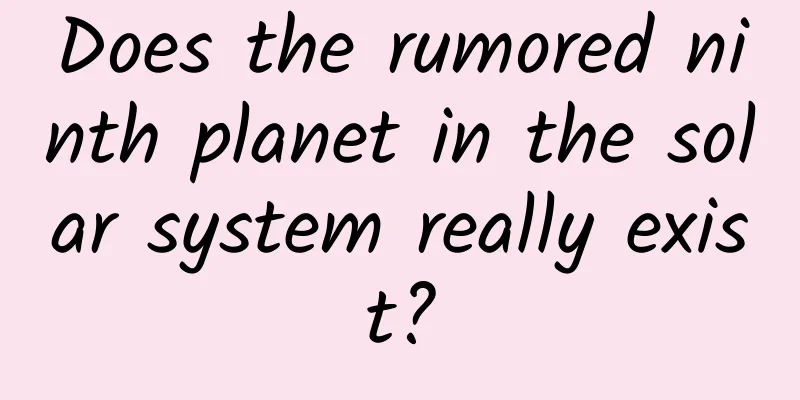Does the rumored ninth planet in the solar system really exist?

|
How many planets are there in the solar system? Eight, but it could be nine. Of course, the ninth planet in the solar system mentioned here is not Pluto, which has been eliminated. Scientists have always believed that in addition to the eight known planets in the solar system, there is an undiscovered ninth planet. As we know, the claim about the ninth planet in the solar system has always been just a rumor, without any solid evidence. So what gives scientists such great confidence? This starts with the discovery of planets. Since ancient times, the most direct and traditional way to discover a planet is direct observation. In ancient times, there were no astronomical observation equipment. The only way for people to understand celestial bodies in the universe was to observe them with their naked eyes, which was actually a very difficult thing. Although the atmospheric conditions in ancient times were relatively good and one could see the stars in the sky, it was very difficult to identify a specific star or even figure out its movement rules. This required extremely firm perseverance and determination to observe the night sky day after day. Even under such limited conditions, the ancients successfully identified many stars and named them. The earliest known map of celestial motion was drawn more than 4,000 years ago by ancient Babylonian astronomers. It is an amazing thing that we can understand the movement of celestial bodies in such detail just by observing with the naked eye. This makes us have to admire the perseverance and wisdom of the ancients. Among the eight known planets in the solar system, except for the Earth itself, five were discovered by the ancients with the naked eye. After the invention of the astronomical telescope, it became much easier to observe celestial bodies. Humans can also use it to observe more celestial bodies that cannot be seen by the naked eye, so the family of planets in the solar system began to expand again. In 1781, British astronomer William Herschel used a homemade telescope to search for comets in his garden and accidentally discovered a star without a comet tail. With many years of experience in astronomical observation, William soon realized that this was an unusual discovery, because what he saw was a planet, a planet in the solar system. Later, this planet was named "Uranus", and it became the first solar system planet discovered by humans with the help of an astronomical telescope. Although the emergence of astronomical telescopes has made it easier for humans to observe the universe, it is not omnipotent. If we only rely on observation, it is hard to say when humans will be able to discover Neptune. How was Neptune discovered? Not by looking at it, but by calculating it. When scientists were calculating the trajectory of Uranus, they found that there was a significant deviation between the actual trajectory of Uranus and the calculated value, which made scientists puzzled. In 1845, a French mathematician named Urban Le Verrier found the answer to this puzzle. He believed that there must be a larger celestial body outside the orbit of Uranus, and its gravitational force disrupted the orbit of Uranus. So Le Verrier found the location of the planet through calculations and confirmed it through observation. So Neptune officially joined the family of planets in the solar system. The reason why scientists insist on the existence of the ninth planet in the solar system is similar to the reason for the discovery of Neptune. Astronomers have found through calculations that the movement of planets in the solar system is still deviated from the predicted data, with obvious irregularities, and the best answer to explain this phenomenon is that there is still a ninth planet in the solar system. Since there is a ninth planet, why can't it be found? Scientists speculate that this planet is likely to exist in the Kuiper belt. Its volume is about five times that of the earth, and its distance from the sun is about 44.8 billion kilometers to 77.8 billion kilometers. It takes 10,000 years to orbit. Due to the long distance and long revolution period, it is difficult to find the specific location of this planet, so it is difficult to find it. However, some scientists have expressed doubts, because from the operation of the stars in the Kuiper belt, it seems that there is no evidence of the existence of massive planets. In summary, whether the rumored ninth planet in the solar system exists is still a mystery, but the charm of science lies in the process of pursuit and exploration. Just thinking about this question has made us excited enough. For more information, please follow the official account: sunmonarch |
>>: You must have tried this "strongest peripheral" of "Man Jiang Hong"!
Recommend
How to eat an anti-inflammatory diet? This dietary pattern is recommended
Recently, the term "anti-inflammatory diet&q...
iOS 16.2 quasi-official version released, karaoke function is here
Early this morning, Apple pushed the iOS 16.2 RC ...
Is Pinduoduo's user growth stagnating?
Pinduoduo (PDD) became a hot topic due to the “pr...
How can we protect the Earth, our only home?
The planet we live on has many ecosystems that ar...
Everything can be "hyaluronic acid"
The temperature dropped a while ago and I had a s...
Is the mantis shrimp in your mouth actually a "martial arts master"?
When it comes to mantis shrimp, many people will ...
Exclusive interview with APICloud CTO Zou Da: A full-stack engineer forced out
[[137215]] In the era of mobile Internet, APP is ...
Three common skills of Growth Hackers
A Growth Hacker is a compound talent who is a com...
Teach you to develop high emotional intelligence communication skills and ignite your sense of humor Baidu Cloud Download
Everyone has emotions, which lead to emotional in...
As the differentiation of domestic brands intensifies, only five brands may survive well in the future
As May begins, the domestic passenger car market ...
How romantic is the underwater starry sky in "Gone Girl"? Would you watch it even if it cost you your life?
Recently, the movie "She's Missing"...
3 tips for video marketing in 2019
It’s already 9102! Today, we are going to give yo...
Foshan mini program production and customization development, what are the processes for developing a mini program?
After the fifteenth day of the first lunar month,...
Chromosome mutations so fast! The mice on the island diverged into six species over a thousand years
Evolution never stops and screening is everywhere...
The top ten trends in the development of self-media in 2017 show obvious polarization
1. Too much content According to third-party data...









